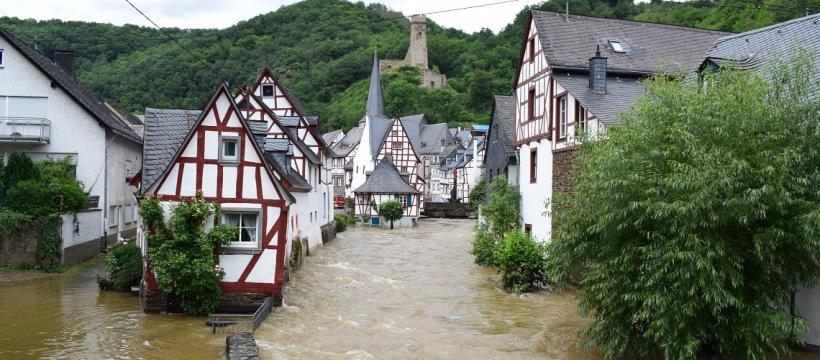Resilient Finance: Closing the Protection Gap Against Disaster Risk

In July 2021, catastrophic flooding inundated parts of Germany and Belgium with damage spreading further into neighboring countries. The flooding took the lives of over 200 people and caused devastating damage to homes and businesses; the insurance industry is expecting losses on the scale of billions of EUR.
Governments will bear much of the cost of this flooding. Germany has announced an immediate aid package of EUR 472 million to support affected people. The European Union Solidarity Fund will likely be instrumental for the recovery. Once again, the floods reminded that we need better systems in place to finance recovery from natural disaster.
Natural disasters are not infrequent in Europe. In the past 40 years, disasters affected almost 7% of the European population costing on average EUR 12 billion losses each year. Given the number of compounding shocks, such as the ongoing pandemic and climate change, financial preparedness is paramount to recovery.
The World Bank and the European Commission recently conducted a study that assessed the status of financial preparedness of Europe to respond and recover from disasters. It found that damage to residential buildings forms over 50 percent of total loss from both flood and earthquake risk. However, only 30 percent of EU member states have more than half the population covered by catastrophe insurance (see Figure 1). This suggests that there is a large protection gap and that many people must rely on government aid to recover.
Figure 1 - Proportion of households covered by catastrophe insurance against earthquakes (left) and floods (right)

Source: AXCO Non-life insurance market reports: Country report 2020s; OECD 2015, 2016, 2018; EU JRC 2012 Note: There are some limitations to the above data, which are in some cases outdated. In addition, when the range of households covered was provided, the upper limit was selected, so the penetration might be overstated.
Insurance instruments could help to close the financing gap posed by natural disasters. Recent research by European Insurance and Occupational Pensions Authority (EIOPA) and the European Central Bank highlighted the role of insurance in mitigating negative macroeconomic and welfare impacts of disasters. If a high share of damage is covered by insurance, the initial fall in economic output following a disaster may be reduced.
The effects from the current flooding in Europe are stark, but expected, according to catastrophe risk models developed for the World Bank and EC. Models estimate damage of major floods and earthquakes in some countries to exceed EUR 50 billion. There is a 1 percent chance of experiencing this loss in any given year.
Figure 2 - Countries with highest estimated average annual loss (AAL) for floods and earthquakes in EUR million

Note: The analysis builds on two regionally consistent probabilistic catastrophe risk models (developed by JBA Risk Management (JBA) for floods and by the Global Earthquake Model Foundation (GEM) for earthquakes). Combining these models with data on disaster risk finance and economic modeling, the analysis reports on the size of costs and potential funding gap EU governments might face. View the full infographic here.
Financial preparedness of European governments to meet such costs differs across the countries, but overall is limited. Large post-disaster costs are shouldered by government budgets. Every year on average, European governments may collectively have to provide more than EUR 16.2 billion through budget reallocations, borrowing and external aid.
Still, there are reasons to be optimistic. With increasing recognition of the need to build financial resilience to climate and disaster risk — as mentioned in the 2021 EU Adaptation Strategy and the EU Green Deal - there are opportunities to strengthen financial resilience of European governments to disasters. Some of these opportunities could be implemented now. For example, developing comprehensive disaster-risk financing strategies to provide finance when needed. Developing such a strategy includes identifying priorities for financial preparedness to disasters and identifying sources of funds to meet post-disaster costs effectively and timely. Other opportunities will take more time and effort. For example, introducing risk-financing instruments, like catastrophe insurance. Building data for financial preparedness is critical for evidence-based decision-making; it is possible to start collecting this data now.
As we recover from COVID-19 and adjust to a changing economy, there is an opportunity to shape this recovery to take a resilient, green and inclusive development path. Strengthening financial resilience to disasters and climate related events will be key to reducing the financial and economic impacts from future crises and make us more resilient.
Photo Credit: M. Volk / Shutterstock
This blog was originally published in the World Bank Group’s Private Sector Development blog.
Financial Resilience Around the World | Blog Series
- Financial Resilience Around the World: Global Risk Financing Facility
- Three Ways Lesotho's Past Experience with Disasters Strengthen COVID-19 Response
- Three Steps to Help Albania Withstand the Financial Impacts of Disasters and Crises
- How the Pandemic Has Highlighted the Need for the Next Generation of Natural Catastrophe Impact Modeling
- How Burkina Faso is Leveraging a Credit Guarantee Scheme to Help SMEs Weather the COVID-19 Economic Crisis
- Using Satellite Data for Climate, Crisis and Disaster Risk Finance
- Learning from COVID-19 and Climate Change: Managing the Financial Risks of Compound Shocks
- Developing Disaster Risk Finance in Morocco: Leveraging Private Markets for Sovereign Risk Transfer
- Rural Resilience: It's Not Only About Insurance
- Leveraging Space Technology for Climate Risk Finance